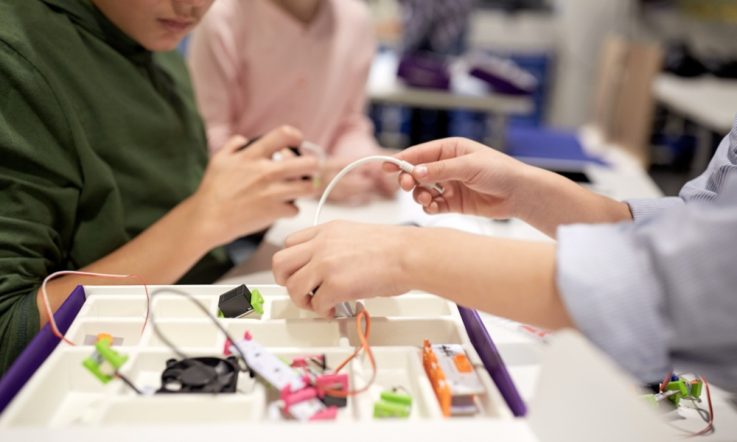This is an edited version of an article that was originally published in the April 2011 print edition of Teacher.
A school is made up of its people, and people are not always rational beings. Gerard Ferrara explains the importance of emotional intelligence.
Many teachers and school leaders would agree with Charles Darwin’s statement in his 1872 book, The Expression of the Emotions in Man and Animals, that the ability to express emotions, such as anger, despair and relief, is connected to survival.
If school leaders want teachers who can do more than just survive the classroom, however, they need to better understand how emotions are expressed, and also how they can be managed; that is, the theory of emotional intelligence, or EI.
Why is emotional intelligence important?
How well do you understand your own emotions? Do you recognise when you’re feeling stressed or frustrated, and do you know how to manage that? How well do you understand and manage the emotions of your colleagues? Of your students?
An emotionally intelligent teacher, for example, recognises that at the start of a school year, students new to the school are likely to be feeling anxious and vulnerable, and handles the Year 7 class differently to the Year 9 class – which is likely to have a whole other range of issues.
A good colleague recognises that most people aren’t at their best first thing on a Monday morning, and chooses to schedule an important meeting for some other time. A good registrar is welcoming and helpful to the parents of potential students looking to enrol in the school.
An EI-savvy school leader knows when a teacher has done a great job on a project, and makes an effort to acknowledge it.
These might seem like simple actions – but how often do we see the opposite occur? For some people, emotional intelligence comes naturally; for others, it doesn’t. The good news is that teachers and school leaders can improve their EI, and leaders can take steps to hire the most emotionally intelligent people as staff.
The theory of emotional intelligence
Emotional intelligence relates to a person’s capacity to perceive, understand and manage their own emotions and those of others, including groups.
Traditionally, discussion about intelligence has had a more narrow focus, concentrating on the cognitive elements, such as problem-solving, memory and reasoning. We often conceive of intelligence as how ‘smart’ a person is, demonstrated by their ability to solve problems relating to numbers, words, shapes, objects and so on. Intelligence quotient (IQ) tests, and intelligence tests used in schools, such as the Stanford-Binet Intelligence Scales, illustrate such a focus on the cognitive elements of intelligence.
In more recent times, the concept of what intelligence is and what it can offer has been challenged. Howard Gardner’s theory of multiple intelligences, for example, recognises people’s capacity to understand the emotions and motivations of themselves and others. Gardner’s work has been well received in a number of schools across Australia – although there is still more value placed on students’ cognitive intelligence than their other abilities.
The concept of emotional intelligence has also been explored in the corporate world since the 1980s, and more widely embraced since Daniel Goleman’s book Emotional Intelligence: Why it can matter more than IQ spent more than 18 months on the New York Times bestseller list in the mid 1990s.
The halo effect
Emotional intelligence flourished in the corporate world because organisations kept hiring smart people – and often they would fail. In the best case scenario, the person would fail and leave; in the worst case, they would have a negative impact on the culture, values or reputation of the organisation, and take the organisation down with them.
Awareness of emotional intelligence can have many advantages for any workplace, but it is important to acknowledge there is still quite a bit of ignorance, resistance and scepticism about it, even in organisations that have hired a consultant, such as myself, to help them improve.
When I consult organisations looking to hire managers, for example, occasionally senior staff members stress ‘real’ management skills, the importance of facts and figures, key performance indicators, change and control. What I suspect these senior managers are thinking, but won’t actually say, is that they believe emotional intelligence is something that a psychologist or human resources person has dreamt up, rather than the measurable, valuable skill that psychological studies have shown it to be.
Similarly, when I run training programs on psychometric testing – which includes emotional and personality testing as well as traditional cognitive testing – there will always be someone who mentions that they have or their son or daughter has done exceptionally well on an IQ test. No-one ever boasts about their level of emotional intelligence. (Interestingly enough, I also never get anyone boasting about the IQ level of their partners – which might suggest that people do value emotional intelligence more highly than cognitive intelligence in some situations!)
Consider the following scenario that I have encountered time and time again. When hiring a new staff member, an organisation’s selection panel will develop a balanced set of selection criteria and key competencies that they would like the new staff member to have. If the organisation’s human resources staff has been involved in setting the criteria, the list may include some ‘people’ qualities. Then, all of the selection criteria will be thrown out the window when:
- a candidate scores very well on the battery of cognitive intelligence tests
- a candidate has a stack of qualifications, especially if the qualifications are from a famous university, and even more especially if they are from the same university as the chief executive officer or chairperson of the board attended
- the candidate has a high profile, or
- all of the above.
Members of the selection panel will assume that if the candidate is so smart, as demonstrated by high cognitive test results, they will be an effective manager and have the capacity to deal with people. Often such a selection will fail, often with spectacular results! Then the panel will meet again and recruit someone with even higher test results or even more impressive qualifications, who may or may not fail again. This tendency to equate traits in one area with traits in another occurs so often it even has a name: the halo effect.
School leaders can avoid the halo effect simply by accepting that there are a lot of cases where the smartest person isn’t necessarily the right option to be part of a team or to be a leader.
Research from the Massachusetts Institute of Technology shows that people who score higher on emotional intelligence tests are more effective as managers and team players. While there is some correlation between a person’s cognitive intelligence and his or her effectiveness in the workplace, the correlations between emotional intelligence and workplace effectiveness are stronger.
Measuring and improving EI
People will naturally have differences of opinion, as there should be in a healthy organisational team. Problems arise when people believe that logic alone can solve these differences. Some people believe that if they can argue the logic of why a decision has been made – essentially, if they can win the argument – then the other person involved will go away satisfied. This ignores, of course, that differences of opinion are more often emotional than theoretical.
We need to be aware of the emotions people around us are experiencing in order to respond appropriately. We need to recognise that people can’t turn off their emotions. We can’t say to a student or a colleague: ‘Stop crying, it’s irrational. Stop getting frustrated, that doesn’t make sense.’ We need to recognise that emotions are a key, legitimate factor in how people interact, and that a school is made up of people and therefore is a complicated mass of emotional interactions.
In schools, that process of understanding emotions might begin with measuring the emotional intelligence of the existing staff. Leaders could also ask applicants for new positions to sit EI tests. The most well-known and commonly used measure of EI is a test called the Emotional Quotient Inventory (EQI), developed by Dr Reuven Bar-On. This is a self-report: participants complete a questionnaire to estimate their own emotional behaviours and style.
Teachers and other school staff are well trained, capable, smart people. But even they, believe it or not, do not always perceive themselves in the same way that other people see them. For this reason, conducting a 360-degree feedback process with staff can be a worthwhile alternative or complement to the EQI. The 360-degree process involves each participant receiving feedback from supervisors and colleagues. This allows us to better understand how others view us, and highlights strengths and areas for improvement that we may not have previously been aware of.
Having an objective assessment is a powerful thing. We all have filters; we have perceptions of ourselves and others from a certain viewpoint – our own – which is valid and legitimate, but it is only one perspective. The most effective people are those who have a fuller understanding of who they are. Once we recognise that getting this information might give us that fuller understanding, staff often look forward to getting the feedback.
Emotionally intelligent leadership
It is important, too, that the school leadership engages in a genuine way with any attempt to promote emotional intelligence in the school. If you don’t understand how people work and how to get the best out of them, you’re not going to reach anywhere near your full potential. At best you’ll have a neutral influence; at worst, you’ll have a negative impact on the school that will take years to correct.
Can the leaders in your school articulate when and why teachers feel happy, satisfied and fulfilled in their work? If you don’t know what the source of that is, how can you ensure you have more of it?
Conversely, do the leaders have a proper understanding of the sources of teachers’ stress? If not, how can the school minimise it? Stress is a huge factor in schools, and it continues to be so because often leaders and management react to staff stress not by trying to understand the emotional causes but by treating the symptoms.
This is also the case when dealing with change. Schools go through a lot of change – but change, for a lot of people, can cause similar emotions, or strength of emotion, to bereavement. Leaders often have time to process their own reactions to change before the change is presented to the staff, and by then the leaders just want to get on with implementing the change – but if the leaders don’t get all the staff involved in the process, there will be resistance, if not overt, then in the form of non-committal and deafening silence, when the change is attempted.
If instead they put themselves in the shoes of the people who are going to be affected, having that level of insight will be very effective. Some staff will react to large-scale change in a school with emotional responses consistent along the lines of Elizabeth Kübler-Ross’ stages of grief: denial, anger, bargaining, depression and acceptance. If leaders can accept that change will have that impact on some people, and design the process of implementation and the structures to support people through it with this in mind, the change is going to have a much great chance of success.
Similarly, EI should be applied to understanding parents’ more general reactions to the school. Many schools, for example, have copped criticism from parents about NAPLAN and the data on My School. Schools need to understand where that is coming from; for many parents, this is an emotional response to do with their deepdown fears, concerns and sense of responsibility about their children’s education and future. What they ultimately want to know is whether the school is sincerely trying to provide a good education and a caring environment. If the school can address those concerns, everything else will resolve itself.
Emotionally intelligent leaders, too, should recognise also that there’s no rule that says that senior people should not recognise the effort and good work of staff below them or in different areas. Why can’t the head of English provide positive feedback to a physical education teacher about the health and fitness programs, or to the gardener about the landscaping?
This links into the need for leaders to understand their own spheres of influence and the negative and positive effect they can have on other people. An example might be a principal who understands that her greeting the parent of a child who has just started at the school will have a more positive impact than the same exchange coming from a teacher.
The EI-savvy principal in the previous example knows that connecting with staff and parents on an emotional level will make them happy; she also recognises the strategic advantage of understanding their emotional responses. Two minutes spent acknowledging a teacher’s success in the classroom will encourage that teacher to continue to strive, and contribute to the retention of that teacher in the long-term. Two minutes spent showing genuine interest in a parent may result in that parent recounting the incident to friends and family, and will have a positive impact on the reputation of the school for years. The argument could be made that a bit of EI is a more powerful and more cost-effective public relations tool than any website or pamphlet could ever be.
Ultimately, emotionally intelligence in leaders and teachers is good for people – but in addition to being an important factor in staff and student wellbeing, it’s also an effective management tool.
This is an edited version of an article that was originally published in the April 2011 print edition of Teacher.



